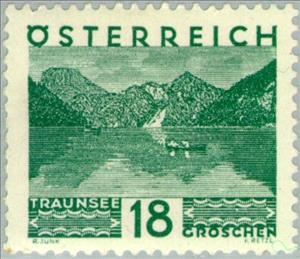Stamp: Traunsee, Upper Austria - large format (Austria 1929)
Traunsee, Upper Austria - large format (Austria 1929)
04 November (Austria ) within release Landscapes goes into circulation Stamp Traunsee, Upper Austria - large format face value 18 Austrian groschen
| Stamp Traunsee, Upper Austria - large format in catalogues | |
|---|---|
| Michel: | Mi:AT 502 |
| Yvert et Tellier: | Yt:AT 381 |
Stamp is horizontal format.
Also in the issue Landscapes:
- Stamp - Güssing Castle, Burgenland - large format, ochre face value 10;
- Stamp - Hoch-Osterwitz Castle, Kärnten - large format face value 15;
- Stamp - Dürnstein, Lower Austria - large format face value 16;
- Stamp - Traunsee, Upper Austria - large format face value 18;
- Stamp - Hohensalzburg Fortress, Salzburg - large format, maroon face value 24;
- Stamp - Seewiesen, Steiermark - large format face value 30;
- Stamp - Old Hofburg, Innsbruck Tyrol - large format face value 40;
- Stamp - Hohenems, Vorarlberg - large format face value 60;
- Stamp - National Library, Vienna face value 1;
- Stamp - Stefans Cathedral, Vienna face value 2;
Stamp Traunsee, Upper Austria - large format it reflects the thematic directions:
A landscape is the visible features of an area of land, its landforms and how they integrate with natural or man-made features. A landscape includes the physical elements of geophysically defined landforms such as (ice-capped) mountains, hills, water bodies such as rivers, lakes, ponds and the sea, living elements of land cover including indigenous vegetation, human elements including different forms of land use, buildings and structures, and transitory elements such as lighting and weather conditions. Combining both their physical origins and the cultural overlay of human presence, often created over millennia, landscapes reflect a living synthesis of people and place that is vital to local and national identity. The character of a landscape helps define the self-image of the people who inhabit it and a sense of place that differentiates one region from other regions. It is the dynamic backdrop to people’s lives. Landscape can be as varied as farmland, a landscape park, or wilderness. The earth has a vast range of landscapes, including the icy landscapes of polar regions, mountainous landscapes, vast arid desert landscapes, islands and coastal landscapes, densely forested or wooded landscapes including past boreal forests and tropical rainforests, and agricultural landscapes of temperate and tropical regions.
Rowing is the act of propelling a human-powered watercraft using the sweeping motions of oars to displace water and generate reactional propulsion. Rowing is functionally similar to paddling, but rowing requires oars to be mechanically attached to the boat, and the rower drives the oar like a lever, exerting force in the same direction as the boat's travel; while paddles are completely hand-held and have no attachment to the boat, and are driven like a cantilever, exerting force opposite to the intended direction of the boat.
A lake is a naturally occurring, relatively large and fixed body of water on the Earth's surface. It is localized in a basin or interconnected basins surrounded by dry land. Lakes lie completely on land and are separate from the ocean, although they may be connected with the ocean by rivers, such as Lake Ontario. Most lakes are freshwater and account for almost all the world's surface freshwater, but some are salt lakes with salinities even higher than that of seawater. Lakes vary significantly in surface area and volume.



